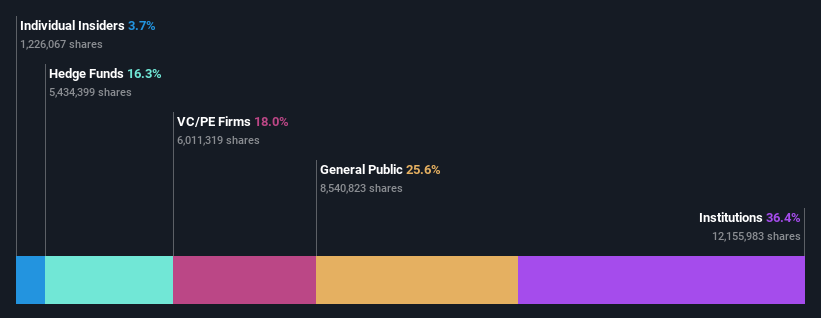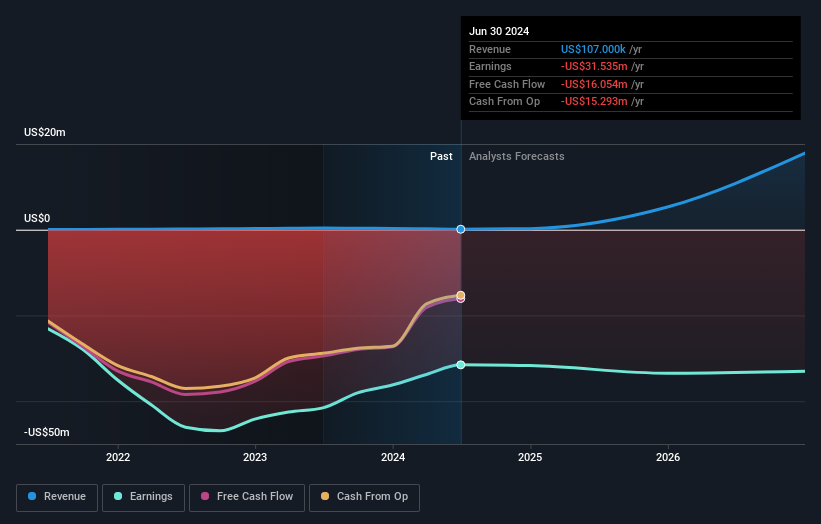- United States
- /
- Biotech
- /
- NasdaqGM:SERA
Institutional investors are Sera Prognostics, Inc.'s (NASDAQ:SERA) biggest bettors and were rewarded after last week's US$32m market cap gain

Key Insights
- Institutions' substantial holdings in Sera Prognostics implies that they have significant influence over the company's share price
- 51% of the business is held by the top 6 shareholders
- Insiders have been selling lately
A look at the shareholders of Sera Prognostics, Inc. (NASDAQ:SERA) can tell us which group is most powerful. And the group that holds the biggest piece of the pie are institutions with 36% ownership. In other words, the group stands to gain the most (or lose the most) from their investment into the company.
And last week, institutional investors ended up benefitting the most after the company hit US$261m in market cap. The gains from last week would have further boosted the one-year return to shareholders which currently stand at 327%.
In the chart below, we zoom in on the different ownership groups of Sera Prognostics.
Check out our latest analysis for Sera Prognostics

What Does The Institutional Ownership Tell Us About Sera Prognostics?
Many institutions measure their performance against an index that approximates the local market. So they usually pay more attention to companies that are included in major indices.
We can see that Sera Prognostics does have institutional investors; and they hold a good portion of the company's stock. This can indicate that the company has a certain degree of credibility in the investment community. However, it is best to be wary of relying on the supposed validation that comes with institutional investors. They too, get it wrong sometimes. If multiple institutions change their view on a stock at the same time, you could see the share price drop fast. It's therefore worth looking at Sera Prognostics' earnings history below. Of course, the future is what really matters.

Our data indicates that hedge funds own 16% of Sera Prognostics. That catches my attention because hedge funds sometimes try to influence management, or bring about changes that will create near term value for shareholders. The company's largest shareholder is Baker Bros. Advisors LP, with ownership of 16%. RA Capital Management, L.P. is the second largest shareholder owning 9.1% of common stock, and aMoon Fund holds about 8.9% of the company stock.
On further inspection, we found that more than half the company's shares are owned by the top 6 shareholders, suggesting that the interests of the larger shareholders are balanced out to an extent by the smaller ones.
While it makes sense to study institutional ownership data for a company, it also makes sense to study analyst sentiments to know which way the wind is blowing. There is some analyst coverage of the stock, but it could still become more well known, with time.
Insider Ownership Of Sera Prognostics
The definition of company insiders can be subjective and does vary between jurisdictions. Our data reflects individual insiders, capturing board members at the very least. The company management answer to the board and the latter should represent the interests of shareholders. Notably, sometimes top-level managers are on the board themselves.
Most consider insider ownership a positive because it can indicate the board is well aligned with other shareholders. However, on some occasions too much power is concentrated within this group.
Shareholders would probably be interested to learn that insiders own shares in Sera Prognostics, Inc.. It has a market capitalization of just US$261m, and insiders have US$9.6m worth of shares, in their own names. Some would say this shows alignment of interests between shareholders and the board. But it might be worth checking if those insiders have been selling.
General Public Ownership
With a 26% ownership, the general public, mostly comprising of individual investors, have some degree of sway over Sera Prognostics. While this size of ownership may not be enough to sway a policy decision in their favour, they can still make a collective impact on company policies.
Private Equity Ownership
Private equity firms hold a 18% stake in Sera Prognostics. This suggests they can be influential in key policy decisions. Sometimes we see private equity stick around for the long term, but generally speaking they have a shorter investment horizon and -- as the name suggests -- don't invest in public companies much. After some time they may look to sell and redeploy capital elsewhere.
Next Steps:
I find it very interesting to look at who exactly owns a company. But to truly gain insight, we need to consider other information, too. Case in point: We've spotted 5 warning signs for Sera Prognostics you should be aware of, and 2 of them are significant.
But ultimately it is the future, not the past, that will determine how well the owners of this business will do. Therefore we think it advisable to take a look at this free report showing whether analysts are predicting a brighter future.
NB: Figures in this article are calculated using data from the last twelve months, which refer to the 12-month period ending on the last date of the month the financial statement is dated. This may not be consistent with full year annual report figures.
New: Manage All Your Stock Portfolios in One Place
We've created the ultimate portfolio companion for stock investors, and it's free.
• Connect an unlimited number of Portfolios and see your total in one currency
• Be alerted to new Warning Signs or Risks via email or mobile
• Track the Fair Value of your stocks
Have feedback on this article? Concerned about the content? Get in touch with us directly. Alternatively, email editorial-team (at) simplywallst.com.
This article by Simply Wall St is general in nature. We provide commentary based on historical data and analyst forecasts only using an unbiased methodology and our articles are not intended to be financial advice. It does not constitute a recommendation to buy or sell any stock, and does not take account of your objectives, or your financial situation. We aim to bring you long-term focused analysis driven by fundamental data. Note that our analysis may not factor in the latest price-sensitive company announcements or qualitative material. Simply Wall St has no position in any stocks mentioned.
About NasdaqGM:SERA
Sera Prognostics
A women’s health diagnostic company, discovers, develops, and commercializes biomarker tests for improving pregnancy outcomes in the United States.
Flawless balance sheet medium-low.


